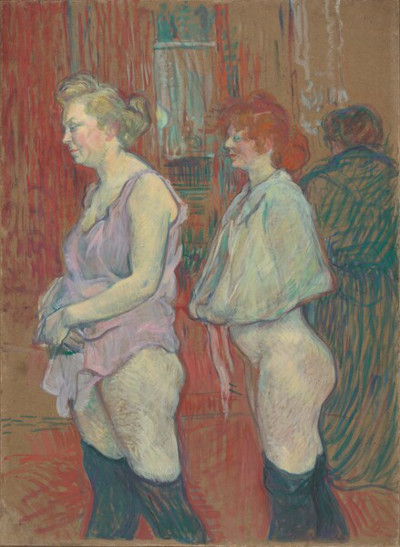Rue des Moulins dates from 1894. This painting has been owned by the National Gallery of Art in the US since around the 1960s.
Within this painting we find a double portrait, with two ladies of the night wandering across an indoor scene. The depictions are honest, and makes no attempt to save the blushes of these two women. The artist was well known in these quarters and so they would have felt comfortable in his company. Toulouse-Lautrec covered a side of Paris that many other artists would ignore, and some even despised. This was an artist, though, who was sensitive to those suffering, and did not judge others as he would not want to be judged himself. Perhaps his own physical problems helped him to show compassion to others, and he was also fortunate in the financial backing that he received, but others did not. Behind the two women is a third figure in a green coat, possibly a paying customer, and there are also features of a room in which they work.
Rue de Moulins is sized at 83.5 x 61.4 cm and has been loaned out to other US art galleries and museums for various related exhibitions. Paul Gallimard originally purchased the painting directly from the artist himself, before it was later bought by Chester Dale who passed it on to its present owners. There is a surprisingly large amount of Toulouse Lautrec paintings to be found within the US, considering how popular he has always remained within his native Europe. This has enabled some impressive exhibitions of his work to be curated in both regions over the past one hundred years or so and interest in his career remains just as strong today as it ever has been. The content is of this particular piece is typical of the artist in the 1890s, where he became bolder and less shy in his portraiture.
Whilst this artwork may not be one of the artist's most famous, it offers an exciting insight into the seedier parts of French society in the late 19th century. It also continues our understanding of the artist's considerable skills with regards figurative art. He specialised in this, though combined it brilliantly with the scenes of life in Paris at that time, including the theatre, cabaret and cafe bars. In this example, clearly, he is delving deeper into the night time economy, offering a glimpse into a world that many would avoid at all costs. His oeuvre was influenced by many, but entirely unique in terms of content.




